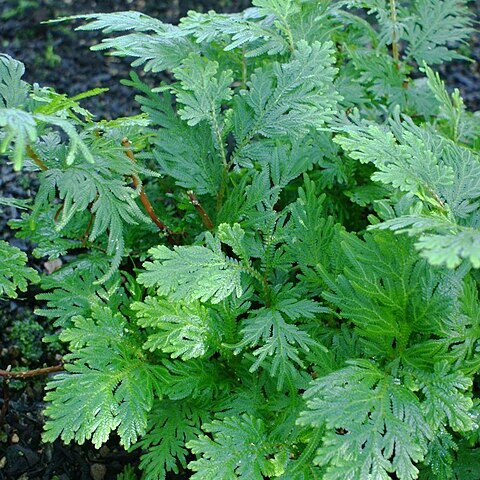Plants terrestrial or epilithic, xerophytic, evergreen or seasonally green, erect, 10-45 cm, with creeping subterranean rhizome and stolons. Rhizophores restricted to creeping rhizomes and stolons, very short. Main stems branched from middle or upper part, pinnately branched, usually stramineous, unbranched main stem (3-)8-13(-25) cm tall, 0.5-2(-3) mm in diam., usually subquadrangular, often pubescent; primary leafy branches 4-8 pairs, 2 or 3 times pinnately branched, branchlets sparse, adjacent primary branches on main stem (3-)5-8(-11) cm apart, leafy branches pubescent on both sides, dorsiventrally flattened, ultimate branches 2.5-4.5 mm wide including leaves. Axillary leaves on branches contiguous or imbricate, narrowly elliptic or falcate, 1.6-2.8 × 0.4-1.2 mm, not carinate, base obliquely decurrent, margin subentire, slightly involute when dry, apex acuminate. Ventral leaves on branches slightly ascending, ovate-triangular or oblong-falcate, 1.6-2.2 × 1-1.8 mm, apex acute or mucronate; basiscopic base decurrent, margin subentire, involute; acroscopic base rounded, not overlapping stem and branches, margin subentire. Strobili solitary, terminal, compact, tetragonal, 5-6 × 1.4-2.3 mm; sporophylls unlike sterile leaves, uniform, not white-margined, broadly ovate or suborbicular, margin denticulate, apex acute; megasporophylls throughout lower side of strobili; microsporangia orbicular; microspores yellowish orange or pale yellow, megaspores whitish.
More
Plants terrestrial, tree-shaped. Stems erect, highly branched, branches 4-forked, flat, not articulate, hispid. Rhizophores not seen. Leaves rugose. Lateral leaves distant, green, ovate-oblong, 2--2.5 X 0.7--1 mm; base truncate, basiscopically forming very short wing; margins green to slightly transparent, usually revolute, crenate; apex obtuse to rounded. Median leaves lanceolate-oblong to asymmetric, 2--3 X 1 mm; base peltate, rounded; margins green to slightly transparent, usually revolute, crenate; apex long-acuminate. Strobili solitary, 2--8 mm; sporophylls monomorphic, cordate to deltate-ovate, base glabrous, margins green, slightly crenate, apex cuspidate to acuminate. 2 n = 20.

